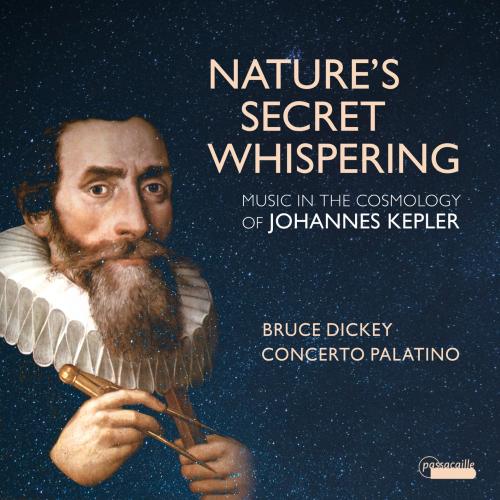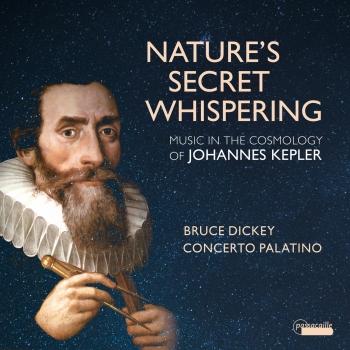
Nature's Secret Whispering: Music in the Cosmology of Johannes Kepler Bruce Dickey & Concerto Palatino
Album info
Album-Release:
2020
HRA-Release:
11.09.2020
Label: Passacaille
Genre: Classical
Subgenre: Vocal
Artist: Bruce Dickey & Concerto Palatino
Composer: Erasmus Widmann (1572-1634), Orlando di Lasso (1532-1594), Andrea Gabrieli (1510-1586), Hans Leo Hassler (1564-1612), Annibale Perini (1560-1596), Lambert de Sayve (1549-1614)
Album including Album cover
- Orlando di Lasso (1532 - 1594):
- 1 Tui sunt cœli a 8 (No. 494 from "Magnum opus musicum, 1604") 02:42
- 2 In me transierunt irae tuae a 5 (No. 263 from "Sacrae cantiones quinque vocum, 1562") 03:55
- 3 Si caelum et caeli caelorum a 6 (No. 401 from "Cantiones sacrae sex vocum, 1594") 03:15
- Andrea Gabrieli (1532 - 1585):
- 4 Deus misereatur nostri in F Ionian Mode (No. 38 from "Concerti, il primo libro, 1587") 03:43
- 5 Beati quorum remissae sunt a 6 (from "Psalmi Davidici, 1583" - Instrumental Version) 02:51
- Hans Leo Hassler (1564 - 1612):
- 6 Jubilate Deo omnis terra, exultate a 12 (No. 13 from "Reliquae sacrorum concentuum, 1615") 04:31
- Annibale Perini (1560 - 1596):
- 7 Cantate Domino a 7 (from "Promptuarii musici, sacras harmonias sive Motetas, Vol. 2, 1612") 04:04
- Lambert de Sayve (1549 - 1614):
- 8 Sacræ symphoniæ: No. 35, Miserere mei, Deus a 6 "De Tempore" 04:41
- 9 Sacræ symphoniæ: No. 124, De profundis clamavi ad te Domine a 10, "Psalmum de Peccatis" 03:40
- Calliope Tsoupaki (b. 1963):
- 10 Astron 10:35
- Erasmus Widmann (1572 - 1634):
- 11 Intrada XIX a 5 - Cantzon XI a 5 (from "Gantz Neue Cantzon, Intraden, Balletten, Courranten, 1618") 04:42
- Lambert de Sayve:
- 12 Sacræ symphoniæ: No. 127, O quam suavis est, Domine a 12, "In Festo Corporis Christi" 02:57
- Andrea Gabrieli:
- 13 Emendemus in melius a 6 (No. 3 from "Concerti, il primo libro, 1587") 03:25
- Annibale Perini:
- 14 Laudate Dominum a 7 (No. 89 from "Promptuarium musicum, Pars Altera, 1612") 03:15
- Orlando di Lasso:
- 15 Tristis est anima mea a 5 (No. 9 from "Modulorum 4-10 vocibus secundum volumen, 1565") 02:41
- 16 Aurora lucis rutilat a 10 (No. 513 from "Magnum opus musicum, 1604") 03:31
- Lambert de Sayve:
- 17 Sacræ symphoniæ: No. 136, Regna triumphalem a 12 "In Coronationem Romanorum Imperatoris" 02:34
Info for Nature's Secret Whispering: Music in the Cosmology of Johannes Kepler
Johannes Kepler (1571-1630), the great mathmetician and anstronomer, was very much concerned all of his life with the connection between practical music and cosmology. He felt strongly that music mirrors the cosmos, and used phrases such as “the Song of the Earth” and “Nature's secret whispering”. In his view, in contrast to the opionions of the ancients, the "music of the spheres” was polyphonic music. He broke from his contemporaries who thought that the motions of the planets and other heavenly bodies actually made sound, but thought that those motions and all of the geometry of the heavens were reflected in the most perfect polyphonic pieces of his time. Kepler actually invited composers to take up the challenge of writing a motet that would incorporate the harmonies he had discovered in planetary data. He felt that Lasso had come closest and used an example of a five-voice motet (In me transient), which he attempted to analyze in planetary terms. He identified each particular vocal part with a planet: soprano (Mercury), alto (Earth and Venus), tenor (Mars), and bass (Saturn and Jupiter). He noted that the motions of each planet suit its particular voice part, with Mercury as “the treble being most free”, Earth and Venus have “very narrow distances between their motions”, Mars as tenor “is free yet proceeds moderately", while Saturn and Jupiter “as the bass, make harmonic leaps.” He also characterized rhetorical melodic leaps in terms of geometrical figures.
Concerto Palatino is offering a program centered on the ideas of Johannes Kepler and the music of his lifetime. This program is at the same time a continuation and expansion of the project “Breathtaking” of Bruce Dickey and Hana Blažíková, which aims to demonstrate the imitation of the human voice by the cornetto and the cornetto-like quality of the soprano voice. In this program we expand that idea to include trombones and male voices. We will take the Lasso motet mentioned above as a point of departure and then explore other polyphonic and polychoral music of Lasso and his contemporaries (Andrea Gabrieli, Lambert de Sayve, etc.). The dramatic centerpiece of the program is an exciting new work of Calliope Tsoupaki, commission for our project. It is called Astron, and sets an Orphic Hymn of invocation to the stars. It is written like a Greek chorus with a soloist and choral group in dialogue with an instrumental ensemble of cornetto, violin, and four trombones.
Bruce Dickey, cornet, musical direction
Concerto Palatino:
Hana Blažíková, soprano
Barbora Kabátková, soprano
Alex Potter, alto
Benedict Hymas, tenor
Jan van Elsacker, tenor
Tomáš Kral, baritone
Jaromir Nosek, bass
Additional musicians:
Veronika Skuplik, violin
Bruce Dickey, cornetto
Charles Toet, trombone
Simen van Mechelen, trombone
Claire McIntyre, trombone
Joost Swinkels, trombone
Kris Verhelst, organ
Bruce Dickey
is one of a handful of musicians worldwide who have dedicated themselves to reviving the cornetto - once an instrument of great virtuosi, but which lamentably fell into disuse in the 19th century.
The revival began in the 1950s, but it was largely Bruce Dickey, who, from the late 1970s, created a new renaissance of the instrument, allowing the agility and expressive power of the cornetto to be heard once again. His many students, over more than 30 years of teaching at the Schola Cantorum Basiliensis, have helped to consolidate and elevate the status of this once forgotten instrument. For his acheivements the Historic Brass Society awarded him in 2000 the prestigious Christopher Monk Award for "his monumental work in cornetto performance, historical performance practice and musicological scholarship." In 2007 he was honored by British conductor and musicologist Andrew Parrott with a "Taverner Award" as one of 14 musicians whose "significant contributions to musical understanding have been motivated by neither commerce nor ego."
In the course of his long career as a performer and recording artist he has worked with most of the leading figures in the field of early music, including the legendary pioneers of historically informed perfomance, Gustav Leonhardt, Frans Brüggen and Nikolaus Harnoncourt. He was a member for over ten years of Jordi Savall’s Hesperion XX , and has frequently and repeatedly collaborated with Ton Koopman, Monica Huggett, Philippe Herreweghe and many others. Of special importance has been his long-time friendship and collaboration with Andrew Parrott, and in more recent years with Konrad Junghänel.
Bruce Dickey can be heard on countless recordings. His solo CD ("Quel lascivissimo cornetto...") on Accent with the ensemble Tragicomedia was awarded the Diapason d’or. In addition to performing, Bruce Dickey is much in demand as a teacher, both of the cornetto and of seventeenth-century performance practice. In addition to his regular class at the Schola Cantorum he has taught at the Royal Conservatory in The Hague, the Accademia Chigiana in Siena, and the Early Music Institute at Indiana University, as well as master classes in the United States, Canada, Europe and Japan. He is also active in research on performance practice, and has published, together with Michael Collver, a catalog of the surviving cornetto repertoire, and, together with trumpeter Edward Tarr, a book on historical wind articulation. In 1997, together with his wife Candace Smith, he founded Artemisia Editions, a small publishing house which produces editions of music from 17th-century Italian convents.
In 1981, Bruce Dickey moved to Italy, partly to be closer to the origins and source materials for his instrument and its music. He currently lives with his wife and daughter in a country house, surrounded by vineyards, outside of Bologna, home of the original Concerto Palatino.
Concerto Palatino
For three decades, Concerto Palatino, under the direction of Bruce Dickey and Charles Toet, has been leading the way in the revival of the cornetto and baroque trombone. Their highly acclaimed concerts and recordings have brought an appreciation of their important but little known music to modern audiences, and stimulated many young players to take up these instruments, practically unknown a generation ago.
Concerto Palatino takes its name from a historical ensemble of cornettists and trombonists which existed in the city of Bologna for over 200 years under the name Il concerto palatino della Signoria di Bologna. Following in the footsteps of these former virtuosi, their aim is to restore these instruments to an active and respected place in concert life, and to cultivate a love of their music among audiences and players alike.
The names Bruce Dickey and Charles Toet are practically synonymous with the modern revival of the cornetto and the Baroque trombone and are largely responsible for the enormous advances that have been made in the last 20 years in playing standards on these instruments. In a collaboration of some 30 years, they have together trained a whole generation of cornetto and trombone players, many of whom have become regular members of Concerto Palatino.
While the core group is comprised of two cornetti and three trombones, this formation is frequently augmented by the addition of brass players, strings, or singers as necessary. Inevitably, much of their repertoire is sacred, as these instruments were a fixture of musical chapels in both the Catholic south and the Protestant north, from the time of the first flowering of Flemish polyphony in the early 16th century through their twilight years at the time of J.S. Bach, one of the last composers to employ them in a serious way.
Concerto Palatino frequently collaborates with other leading ensembles, in particular Cantus Cölln (Konrad Junghänel), Collegium Vocale Ghent (Philippe Herreweghe), Tragicomedia (Steven Stubbs and Erin Headley), the Amsterdam Baroque Orchestra (Ton Koopman), and the Bach Collegium Japan (Masaki Suzuki), but the members are also asked to join other well-known ensembles, even orchestras of opera-houses all over the world for productions of the operas of Claudio Monteverdi and other composers. So Concerto Palatino was enthousiastically welcomed on most of the prestigious festivals and stages all over the world.
Concerto Palatino places a high priority on unearthing neglected gems of music history and giving them a place in the concert hall and record catalogs alongside the works of established masters. Thus, in addition to highly acclaimed recordings of Schütz, Gabrieli, and Monteverdi, they have made premiere recordings of the Marian Vespers of Francesco Cavalli, the Missa Maria Concertata of Christoph Strauss, and Palestrina’s Missa sine nomine preserved in a manuscript of J. S. Bach. Their numerous recordings for EMI Reflexe, Accent, and harmonia mundi France have received high acclaim. In particular, a major series of recordings together with Cantus Cölln (Vespers of Monteverdi and Rosenmüller, Schütz’ Psalmen Davids and Symphoniae sacrae, the Selva Morale e spirituale by Monteverdi) has won numerous prestigious awards.
This album contains no booklet.










